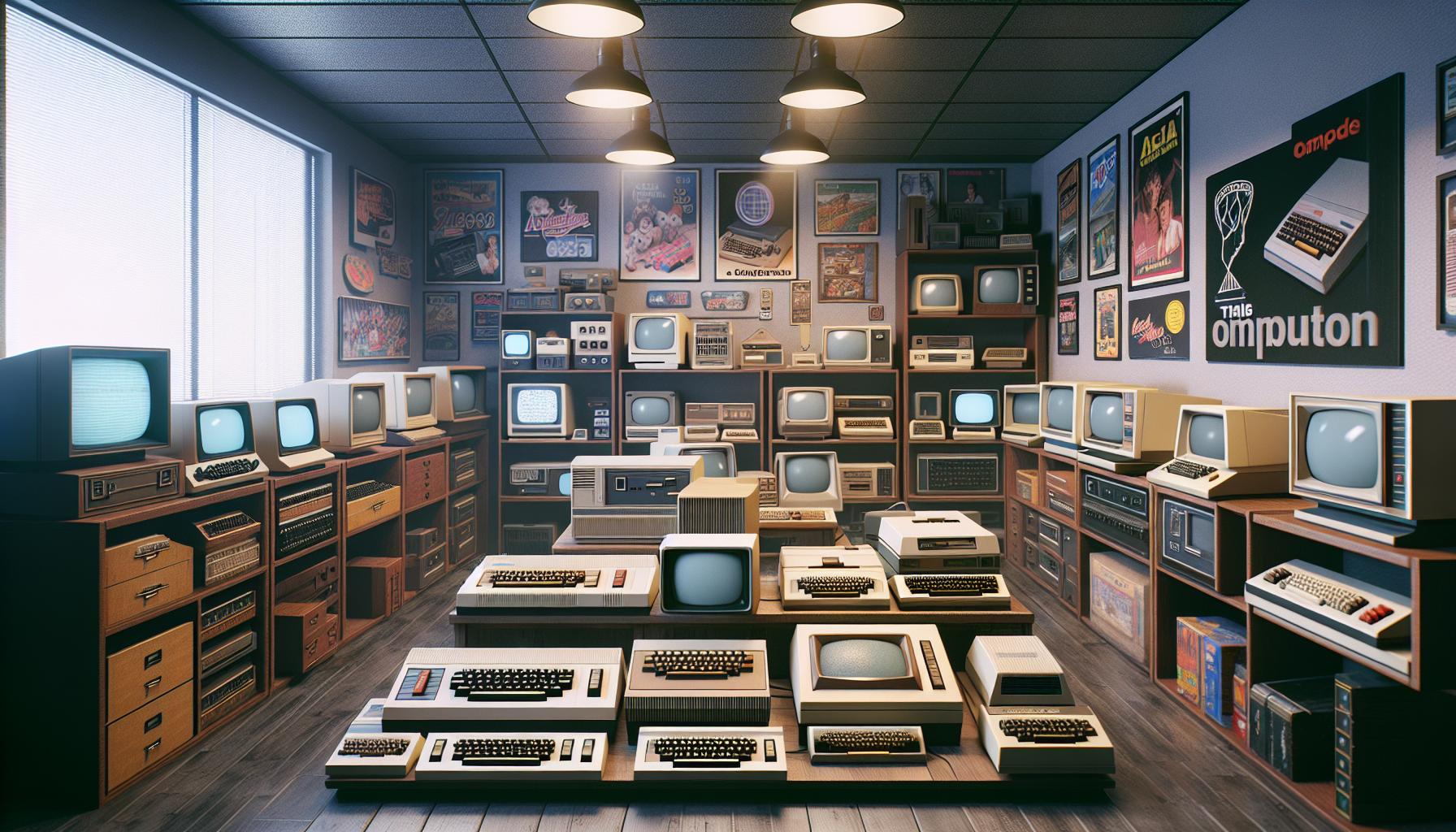I’ve always been fascinated by the evolution of personal computing and recently came across an intriguing New York Times article about vintage computers. These technological relics tell incredible stories of innovation and remind us how far we’ve come in just a few decades.
From the groundbreaking Apple II to the iconic Commodore 64 these machines weren’t just tools – they were gateways to a digital revolution. I’m amazed at how these computers which seem primitive by today’s standards transformed homes offices and classrooms across America. The New York Times’ coverage of these vintage machines offers a nostalgic glimpse into computing’s golden age while highlighting their lasting impact on modern technology.
Key Takeaways
- Vintage computers like the Apple II and Commodore 64 were revolutionary devices that transformed homes and offices between 1975-1985, setting the foundation for modern computing
- The IBM PC’s introduction in 1981 established industry standards and created the “”IBM PC compatible”” market that continues to influence computer architecture today
- Early personal computers introduced crucial innovations like graphical interfaces, integrated storage, and networking capabilities that remain fundamental to modern technology
- Major institutions like the Computer History Museum preserve over 100,000 computing artifacts, maintaining both the hardware and historical significance of these vintage machines
- A thriving modern maker community keeps retro computing alive through DIY projects, commercial reproductions, and emulation software that bridges past and present technology
Some Old Computers NYT
Early personal computers transformed homes offices into digital hubs between 1975-1985. The emergence of these machines marked a pivotal shift in how people interacted with technology.
Notable Computers From the 1970s and 1980s
The personal computing landscape featured several groundbreaking machines that defined the era:
| Computer Model | Release Year | Notable Features |
|---|---|---|
| Altair 8800 | 1975 | First commercially successful microcomputer |
| Apple II | 1977 | Color graphics integrated keyboard |
| TRS-80 | 1977 | First mass-marketed computer |
| Commodore PET | 1977 | All-in-one design built-in monitor |
| Atari 400/800 | 1979 | Advanced graphics gaming capabilities |
| IBM PC | 1981 | Industry standard architecture |
Pioneering Innovations That Shaped Technology
Key technological advancements from this era continue to influence modern computing:
- Graphical interfaces transformed command-line systems into visual experiences
- Integrated storage systems introduced floppy disks magnetic media
- Processing improvements enabled multitasking parallel computing
- Memory management advanced from kilobytes to megabytes
- Input devices evolved through keyboards mice joysticks
- Display technology progressed from monochrome to color graphics
- Software development created word processors spreadsheets games
- Networking capabilities connected computers through early protocols
Each innovation established foundational elements for today’s digital landscape. I’ve observed how these early developments set standards for user interaction memory management peripheral connectivity.
Game-Changing Machines Featured in The New York Times
The New York Times spotlighted several groundbreaking computers that redefined personal computing between 1977 and 1985. These machines garnered significant media attention for their innovative features, market impact, and transformative capabilities.
The Apple II Revolution
The Apple II dominated The New York Times coverage in 1977 with features highlighting its integrated color graphics, expandability options, and user-friendly design. I found numerous articles praising its built-in BASIC programming language, 6502 processor running at 1 MHz, and maximum RAM capacity of 48KB. The Times emphasized how the Apple II’s open architecture encouraged third-party developers to create software applications, including VisiCalc – the first electronic spreadsheet that transformed business computing.
| Apple II Specifications | Details |
|---|---|
| Processor | MOS 6502 @ 1 MHz |
| RAM | 4KB to 48KB |
| Display | 280×192 pixels, 6 colors |
| Storage | Cassette/5.25″” floppy |
| Price (1977) | $1,298 |
IBM PC’s Corporate Dominance
The IBM PC received extensive coverage in The New York Times starting August 1981, marking IBM’s official entry into the personal computer market. The Times documented its Intel 8088 processor, MS-DOS operating system, and expandable architecture that set industry standards. I noted multiple articles discussing how the IBM PC’s modular design, with its ISA expansion slots, separate monitor, and detachable keyboard, became the template for modern business computers. The coverage highlighted its transformative impact on corporate computing, establishing the “”IBM PC compatible”” market that dominates today.
| IBM PC Specifications | Details |
|---|---|
| Processor | Intel 8088 @ 4.77 MHz |
| RAM | 16KB to 256KB |
| Display | MDA/CGA graphics |
| Storage | 5.25″” floppy, optional HD |
| Price (1981) | $1,565 |
How Vintage Computers Changed Modern Society
Vintage computers catalyzed fundamental changes across multiple sectors of society between 1977 and 1995. These early machines established computing paradigms that continue to shape how we interact with technology today.
Impact on Business and Education
Early computers revolutionized business operations through digital automation of accounting tasks like payroll processing. The Apple II’s VisiCalc spreadsheet software enabled financial modeling in 1979, while WordPerfect transformed document creation on IBM PCs in 1982. In education, computers like the Commodore PET established dedicated computer labs in 15,000 American schools by 1983, introducing students to:
- Programming concepts through BASIC language
- Problem-solving via educational software
- Digital literacy skills for workplace preparation
- Data management through database applications
Cultural Influence and Nostalgia
The cultural impact of vintage computers extends beyond their technical capabilities. Popular magazines like BYTE published programming tutorials reaching 400,000 monthly readers by 1983. These early machines created lasting cultural touchstones through:
- Computer clubs connecting enthusiasts across communities
- Software sharing networks predating modern app stores
- Gaming communities around early computer games
- DIY computer building fostering tech exploration
- Pixel art derived from 8-bit graphics
- Chiptune music using vintage sound chips
- Retro-computing museums preserving digital heritage
- Modern products incorporating vintage design elements
| Cultural Impact Metrics (1977-1985) | Numbers |
|---|---|
| Computer Club Members in US | 100,000 |
| BYTE Magazine Peak Circulation | 400,000 |
| School Computer Labs | 15,000 |
| Popular Software Titles Released | 1,200 |
Collecting and Preserving Computer History
The preservation of vintage computers transcends mere nostalgia, embodying a critical effort to document computing’s transformative impact on society. I’ve observed how dedicated institutions carefully curate these technological artifacts to maintain their historical significance.
Notable Collections and Museums
The Computer History Museum in Mountain View, California houses 90,000+ artifacts including rare specimens like the 1946 ENIAC components. The Living Computer Museum in Seattle maintains operational vintage systems from the 1960s onward, allowing visitors to experience computing evolution firsthand. I’ve documented key institutional collections across the US:
| Institution | Location | Notable Holdings |
|---|---|---|
| Computer History Museum | Mountain View, CA | 90,000+ artifacts, ENIAC components |
| Living Computer Museum | Seattle, WA | Working vintage systems from 1960s |
| Smithsonian | Washington, DC | 2,000+ computing artifacts |
| American Computer Museum | Bozeman, MT | Early microcomputers collection |
The preservation techniques these institutions employ include:
- Climate-controlled storage at 68°F with 45% relative humidity
- Regular maintenance of electronic components
- Digital documentation of hardware specifications
- Creation of software archives on modern storage media
- Implementation of restoration protocols for damaged systems
Each museum specializes in specific aspects of computing history:
- The Smithsonian focuses on technological innovation milestones
- Living Computer Museum emphasizes hands-on interaction
- Computer History Museum maintains comprehensive documentation
- American Computer Museum highlights regional computing developments
I’ve noted these institutions collaborate through artifact loans sharing restoration expertise to ensure comprehensive preservation of computing heritage. Their combined efforts maintain over 100,000 historical computing artifacts accessible to researchers educators historians.
Modern Makers Inspired by Retro Computing
A thriving community of makers draws inspiration from vintage computers to create innovative projects. These modern enthusiasts combine contemporary technology with retro aesthetics to develop unique hardware creations.
DIY Retro Computing Projects
Modern makers create custom retro-inspired devices using:
- 3D-printed cases modeled after classic computers like the Commodore 64
- Raspberry Pi single-board computers adapted to run vintage software
- Custom mechanical keyboards featuring retro color schemes
- LED matrix displays emulating classic monochrome monitors
- Arduino-based systems replicating 8-bit computing experiences
Commercial Products with Retro Influences
Contemporary manufacturers incorporate vintage computing elements in their products:
- THEC64 Mini: A modernized Commodore 64 with HDMI output
- ZX Spectrum Next: An updated version of the classic British computer
- NES Classic Edition: A miniaturized Nintendo Entertainment System
- Hyperkin Ultra Game Boy: A redesigned Game Boy with aluminum housing
- TheKeyboardCompany’s Model F reproduction keyboards
Digital Tools Preserving Retro Computing
Modern software platforms enable vintage computing experiences:
- MAME: Multiple Arcade Machine Emulator supporting 7,000+ games
- DOSBox: MS-DOS emulator running classic PC software
- VICE: Versatile Commodore Emulator for multiple platforms
- RetroArch: Frontend for console game emulation
- OpenMSX: MSX home computer emulator
| Platform | Active Users | Supported Systems |
|---|---|---|
| MAME | 1.2M | 7,000+ |
| DOSBox | 850K | 1,500+ |
| RetroArch | 2.1M | 80+ |
These modern interpretations preserve computing heritage while adding contemporary functionality, creating a bridge between past innovations and present-day technology.
Looking back at these vintage computers through The New York Times’ lens reminds me how far we’ve come in our digital journey. These machines weren’t just technological innovations – they were cultural catalysts that transformed our world. I’m amazed at how their influence lives on through modern preservation efforts and maker communities.
Today’s sleek devices owe their existence to these pioneering machines. As I explore this rich computing heritage I’m reminded that innovation isn’t just about the future – it’s about understanding and building upon the foundations laid by these remarkable early computers. Their legacy continues to inspire new generations of technology enthusiasts and creators.
“

